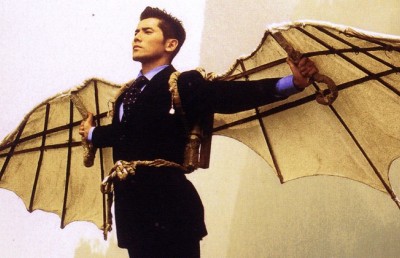The Work of Cinema in the Age of Digital (Re)production
Walter Benjamin Revisited

Two years after the birth of the Third Reich, in “The Work of Art in The Age of Mechanical Reproduction,” Walter Benjamin spoke ambivalently about the implications of mass reproduction of works of art in the capitalist industrial culture of the 20th century. On the one hand he warned that “even the most perfect reproduction of a work of art is lacking in one element: its presence in time and space.” The loss of authenticity, in Benjamin’s view, jeopardized its unique historical testimony, thus depleting it of its ‘aura.’ But on the other hand, he welcomed the political power that mechanical reproduction of the work of art granted the masses in the form of emancipating art from “its parasitical dependence on ritual.” 1
Emblematic to Benjamin’s argument was cinema’s role in the way it changed the reaction of the masses to the work of art: “ The characteristics of the film lie not only in the manner in which man presents himself to mechanical equipment but also in the manner in which, by means of this apparatus, man can represent his environment.” To Benjamin, the technology of reproduction of image and sound substituted photography and cinema for the traditional forms of art such as painting and theater, thus providing the masses with a new vocabulary for communication of politics and ideologies. Today, following another technological leap into the realm of electromagnetic reproduction, we are to ask a similar question: How do the dialect of virtual imagery and the idiom of electronic art modify the syntax of our by now traditional form of art, the cinema? Can this new language evolve into a new political and social discourse, revolutionizing the modes of cultural and ideological communication in the same capacity as cinema did in the age of modernity?
One is best equipped to project the trajectory of the present state of the new media into the future of cinematic discourse using the tools of history. In this essay, I will draw attention to parallels between early cinema (1895-1907) and the one which is promised by the advent of the new image technologies; and then, following the path of early cinema’s evolution into the narrative form to which we are now accustomed, I will point to how the new paradigm of moving pictures can both resemble or deviate from traditional cinema, in both the formation of meaning and experience.
To focus the scope of this essay I have adopted the term hypercinema in order to refer to the formal aspects of a cinema which is equipped by 1) virtual reality and digital simulation at the level of mise-en-scene (such as virtual actors, digital spaces and hyper-real motifs), 2) artificial intelligence as an apparatus for capturing or constructing the image, in other words replacing the human eye behind the camera with that of a machine and 3) an interface which allows individual interaction with the narrative.
Defined in such terms, hypercinema is not a futuristic concept but one which has been pioneered by Lucas Films and DreamWorks within the narrative framework of Hollywood (films such as Star Wars, 2000 and AI: Artificial Intelligence, 2001). But Hollywood fantasy is not the only realm inhabited by hypercinema; Mike Figgis’ independent production Timecode (2000) is an example of an experimental narrative which uses digital technology and artificial intelligence of cameras in order to explore the extra dimension of reality by creating a parallel narrative told in four frames distinct in action and separated in space. The interactivity is granted to the viewer in two ways: one by the digital technology of DVD players that permits the viewer to manipulate the way in which the narrative is revealed and the second at a cognitive level: allowing the viewer the choice to focus on the frame which most interests his/her taste or curiosity.
Since the advent of sound, narrative film has dominated the scope of cinematic experience, to such extent that much of our film theories and cultural studies have been dedicated to using the language of film to convey a meaning or to decipher its text. The new digital and electronic technologies are well on their way to expanding the narrative dimension of hypercinema. As we become increasingly accustomed to artificially created virtual realities, the realism of the image and the invisibility of the apparatus, which have been the founding blocks of the classical narrative, take a secondary role to the exhibition of technology, drawing attention to the very apparatus used to construct the narrative. The acknowledgement of the story-telling device distances the viewer from the fictional world of the plot and encourages —in Deleuze’s terms— a “haptic” immersion in the picture which may or may not lead to hermeneutics.
I will use the term cybercinema to add to the narrative connotation of hypercinema:
- the poetics of the virtual imagery, or the non-narrative and oneiric possibilities provided by digital technology in creation of images which are not entirely divorced from meaning but are more dedicated to intensity and duration of an experience and to “haecceity” 2 – to borrow from Deleuze again – and;
- the cult of digital image production and distribution, which includes both a multi-million dollar production company such as DreamWorks, as well as a home computer in the basement of an amateur with little but free software for simulation of images and creation of virtual realities.
Therefore, according to this terminology, cybercinema also encompasses the hypercinema which is more focused on narrative and traditional forms of address on a 2D screen.
Now the question is, how, if at all, do these definitions of hyper- and cyber-cinema relate to the traditional one? Tom Gunning points out the identity crisis of cinema, a “flux and uncertainty” in the post-film era by which the new image technologies “threaten not only film’s continued existence but its very definition.” Gunning writes: “in the first half of the 20th century film theory labored to endow cinema with a unique identity, to differentiate it from the older arts,” this identity however, seems to be “dispersed into a number of new image technologies […] dissolving into a postmodern haze.” 3 However, from a historian’s retrospective point of view, he observes that “cinema’s apparently chaotic present recalls in many aspects its origins about a century ago.” He continues that recognizing the recurrence of this historical cycle opens up a non-linear conception of the past from which the “shards of a future discarded or disavowed” can be discovered. 4
The historical precursors of cybercinema can be traced back to exhibition techniques such as Panorama, Fantasmagoria and Kinetoscope. The core resemblance between these image techniques and cybercinema rests not only in the principle mechanisms of their operation but also in the reasons for which they have come to exist, as well as the ways they attempt to hide or display the verisimilitude or fantasy.
Panorama (Greek composite, pan_=all, and _horama = view) was invented in 1787 by an Irish painter, Robert Barker, who thought of reproducing a painting on a cylinder encircling the viewer. By overcoming the difficulties of achieving the right perspective, and of mounting and lighting such large pictures, Barker produced a panoramic image of London and patented his invention in 1792. 5 As Soke Dinkla suggests, Panorama changed “the web of relations between things” in the image and “conveyed a new image of the world,” where the single vanishing point of the baroque observer was substituted by a ‘democratized’ point of view, that of the observer; a mobile point of view based on the viewer’s decision to choose the part to which he/she would pay greatest attention. 6 The panoramic scene intersects the virtual reality of the cybercinema to the extent that it engages the viewer actively. As Dinkla points out, the observer is not placed in front of the image, but surrounded by it, occupying an imaginary space inside the image, “an image which is intended to resemble as closely as possible the experience of being surrounded by or being inside nature in reality.” 7
The verisimilitude of the experience is the premier junction where Panorama and cybercinema intersect. The computer technologies that have bestowed virtual reality and simulated imagery to the cybercinema have been primarily concerned with imitation of the outer reality such as to create an experience of space or action. Just as Panorama shifted the boundaries between the real space and natural space, the virtual reality of the cybercinema shifts the boundaries between the reality of objects and the experience of the reality.
Panorama and the interactive aspect of hypercinema also meet at the point of address. In contrast to painting, panorama did not address an individual, but a large number of spectators who could simultaneously observe very different scenes of a panorama. In Dinkla’s words “[t]he panoramic gaze constituted access.” On the other hand, by denying the full view of the image at once Panorama forced an increased level of the spectator’s attention. 8 If we take a film like Time Code to be the first prophetic sign of cyber technologies that have been promising an individualized cinematic experience, we will note striking similarities between this particular version of cybercinema and the panoramic image. In Time Code, Mike Figgis benefits from the digital technology in order to program and synchronize four digital cameras that simultaneously record the events of the plot – 90 minutes of life in Hollywood – in four different locations. The spectator is then simultaneously presented with the images recorded in four different locations, four different sound tracks, and four different actions, reproduced in a four-way split screen. The DVD release of the movie allows the viewer to view each frame at a time and in doing so to edit the movie sequentially, as he/she desires. The theatrical release of this movie, however, must have had the same dazing effect on the audience that the first observers of Barker’s first Panorama experienced. Although the theatrical release of Timecode as projected film did not grant the full degree of interaction, it still challenged the viewer to experience the image actively and to comprehend the multidimensional space of a parallel narrative. This example clearly highlights the point of historical intersection between Panorama, in contrast to painting, and between interactive hypercinema and film. Just as Panorama multiplied the perspective and changed the web of relations between the objects of an image, hypercinema multiplies the objects of the viewer’s gaze and allows a non-sequential access to the web of relations between the elements of a plot. Interactive hypercinema and Panorama both invoke the notion of a mobilized and active gaze.
In December 1995, the editors of Quandary Reviews, a games and adventures magazine wrote: “For better or worse the age of the ‘interactive movie’ is upon us with the release of Phantasmagoria from Sierra.” 9 Phantasmagoria is an interactive horror computer game with full motion video (FMV) and real actors, and with what were at the time controversially violent and gory scenes. As Roberta Williams, the prominent graphic adventure designer and the creator of Phantasmagoria suggests, the game was to invoke the gothic feelings of the old magic of a 17th century “Fantasmagoria show,” where the ghosts of the dead and spirits were brought into the view of the spectators. 10 The magic lantern has been long christened as one of the fore fathers of cinema and the gothic horror of Fantasmagoria has been carried over in the form of the horror genre (with the aid of special effects technologies). The history of Fantasmagoria in the age of Enlightenment, however, parallels cybercinema in its ability to advertise itself as scientific, rational and at the same time astounding. 11Tom Gunning quotes Paul Philidor, the inventor of the Fantasmagoria in 1793: “I pretend to be neither priest nor magician; I have no wish to deceive you; but I know how to astonish you.” 12 Today’s creators of computer-generated special effects resemble the optics specialists of the Enlightenment era. Gunning writes: “The purveyors of magical illusions learned that attributing their tricks to explainable scientific processes did not make them any less astounding, because the visual illusion still loomed before the viewer, however demystified by rational knowledge that illusion might be.” 13 The computer-aided cineastes of today also do not seek to hide the elaborate scientific and technological tricks of their trade from the spectators; on the contrary, the very devices of image making and effect generation are now a source of entertainment in their own right.
Although the demystification of the source of shadows and sounds removed the magic lantern technology from the hands of priests and black magic charlatans, it did not stop haunting the imagination of spectators. In fact in Britain, despite the arrival of cinema in 1895, it remained the most widely accessible form of pictorial entertainment for another two decades. However, the invention of Fantasmagoria generated a new pictorial lexicon for artistic and creative expression; one which has since evolved into our current fantasy genre. Similarly, the computer technologies that constitute cybercinema are capable of expanding the horizon of narrated image beyond the boundaries available to celluloid film and optical cameras. The release of Spielberg’s highly computerized Artificial Intelligence in 2001 made many wish that death had granted Kubrick sufficient time to overcome the “insufficiency” of technology, which prevented him from making Artificial Intelligence. In Kubrick’s hands, A. I. would have found a different artistic expression.
The extension of narrative possibilities by means of digital technology may be the most trivial topic for theorization but not the most prevalent one. The most revolutionary aspect of cybercinema and that which differentiates it from traditional cinema is not narrative, but the apparatus of image making. Regardless of the complexity of the techniques that have been used to articulate the cinematic language – to quote the digital media artist Lev Manovich – “[c]inema remains the art of index; it is an attempt to make art out of a footprint.” 14 On the other hand, cybercinema does not have its root in the physics of optics, nor in photorecording of reality, but rather in creating discrete images of objects and bringing them to life through animation.
Cinema was not conceived as a recorder of reality, or an art of audiovisual narrative, nor did it aim for collective spectatorship in its beginnings. Proto-cinematic techniques of the 19th century, such as the Phenakistiscope, the Thaumatrope, the Zootrope, the Praxinoscope, and the Choreutoscope, created ‘moving pictures’ by manual animation of hand painted images. 15 It was the ease of photographic re-production of the image and the coherence of mechanically generated movement, along with the ability of film to project the reality of the modern age, that pushed animation into the periphery of motion pictures, reserving the manual manipulation of the image for the creation of special effects. Manovich writes that it was “[t]he opposition between the styles of animation and cinema [that] defined the culture of the moving image in the twentieth century.” As he points out, “[a]nimation foregrounds its artificial character, openly admitting that its images are mere representations.” The graphic visual language of animation is in opposition to the indexical and photographic idiom of film, with its discrete and crudely rendered movement of characters against a stationary and detailed background standing in contrast to the uniform sampling of motion by a film camera. Animation’s construction of space from separate layers of image as opposed to different lengths of lenses are characteristics that led Manovich to define digital cinema as “a particular case of animation which uses live action footage [only] as one of its many elements.”
Similar to the animated images of the 19th century, computer generated motion pictures are constructed individually, and the spatial and temporal coherence or discordance of the action in them is a function of the artist’s ability – or desire – to interpolate the matrices of the image(s) with details. As an example we can look at the debut digital film, Tomas Est Amoureux (Pierre-Paul Renders, Belgium, 2000). The story of an (always off-screen) agoraphobic character in search of cyber-love is told in the claustrophobic setting of a near, rather lax, hyper-tech future. The director uses seven different digital cameras in thirteen sets, and communicates with his actors only via monitors and earphones. Director Renders employs a variety of cybercinematic styles to create a cyber-reality which is removed and distinguished from the reality of film by means of acknowledging the digital apparatus used in its making. On the one hand, he creates the virtual reality of the “sextoon” (an electronic sex market that allows an interactive assemblage of a personalized dummy) by methods of traditional animation, and uses the computer technology to make the animation as life-like as possible. On the other hand, he modifies and, at times, pixilates the images of the real characters to add a certain artificiality to their on-screen existence. He displays the ability of cybercinema to create “visio-poems,” digitally enhanced images of nature, depictions of God, and temporality distorted events, as did Barker’s panorama and Robertson’s Fantasmagoria. He also inserts enough digital noise to draw attention to the limitations of the operator and the apparatus, as did the animators of the Kinetoscopes.
Another striking similarity rests in the genesis of these fantasy-making technologies. As Tom Gunning points out, it was primarily the scientific interest of the French Physiologist, Etienne-Jules Marey (1830-1904) that led to the birth of ‘instant’ photography, which made the transition from animation to cinema possible. 16 Marey was interested in the mechanical recording of an individual’s blood circulation. In 1880 he met with Eadward Muybridge, who was commissioned by Stanford university to provide photographic evidence for horses’ locomotion. In advancing Muybridge’s technology of recording animal motion, Marey invented a clocked photographic mechanism so that when the shutter was tripped it made twelve exposures of 1/72nd of a second each. He used this device to record the changes in the shape of birds wings during flight in relation to air resistance, thus making a significant contribution to the knowledge of aerodynamics. 17
Similarly, the age of space exploration, the fascination with genetics of life, and the medical demand for a view of internal images of body’s anatomy and function (and I choose to ignore the – renewed – military interest in science) have necessitated an increase in computer speeds which is beyond any mechanical imagination, while the exponential increase in the computer’s capacity to hold and process information is beyond the imaginable perception of the human brain.
It is ironic that as science demystifies the secrets which haunt our imaginations, ‘entertainment’ fills in the gap of the departing God. Science shed a light of ‘optics’ on superstitious fears of the spectators of Fantasmagoria, but the movie theater became the new Mecca of capitalist/Marxist/fascist/feminist gods. And now that science is making modest progress in replicating the physics and physiology of human cognition and conscience, we have embarked on a fantasy ride along artificial intelligence. Perhaps this new cyber-universe will someday even settle our postcolonialist/postmodernist/postfeminist/poststructuralist/post-etcetera anxieties. In fact, the most significant outcome of appropriation of science by entertainment is not the production of more fascinating fantasies, but more realistic fictions.
As Jean Baudrillard writes: “It is precisely when it appears most truthful, most faithful and most in conformity to reality that the image is most diabolical,” he then continues “it is in its resemblance, not only analogical but technological, that the image is most immoral and perverse.” 18 The Neo-Marxist perspective of Baudrillard, in a postmodern culture of signs where the masses are bombarded by hyper-real images, has an historical precedent. In fact, it invokes the memory of Baudelaire’s distrust of photography in the 19th century, as he perceived it as a threat and tried to put it down as – to paraphrase Benjamin – “a mistaken development promoted by the stupidity of the broad masses who demanded an ideal that would conform to their aspirations.” 19 Much of the Marxist criticism on the technology of the ‘image,’ of which cinema is the most influential, is pointed at its mass-(counter) production of cultural commodities, plus its contribution to the establishment of a capitalist consumer society. The masses are lured by the iconic appeal of the picture. As Herbert Marcuse writes, “the irresistible output of the entertainment and information industry carry with them prescribed attitudes and habits, certain intellectual and emotional reactions which bind the consumers… to the producers” and thus, “the products indoctrinate and manipulate; they promote a false consciousness which is immune against its falsehood.” 20 The roots of cynicism about the indoctrinating power of the illusionary images can perhaps be traced as far back as 1799. As Charles Musser writes, in the early years of the 19th century: “[the] emerging capitalism had little apparent use for the magic lantern during the first 100 years of its invention,” and the ideological and commercial possibilities of the screen were primarily exploited in revolutionary France by the “newly victorious bourgeoisie.” 21 The anticlerical outlook of the French revolution was expressed by Gasper Etienne Robert (Robertson), who opened his Fantasmagoria show with this address: “That which is about to happen before your eyes, messieurs, is not frivolous spectacle; it is made for the man who thinks, for the philosopher who likes to lose his way for an instant …This is a spectacle which man can use to instruct himself in the bizarre effects of imagination.” 22
The dialectical remark of Robertson on the simultaneous realization that a projected image could invoke real fears and emotions is applicable to a critical discourse of the cybercinema apparatus. While the indexical nature of a film image increases the believability of the photo-realistically captured scene, the awareness of a digitizing apparatus creates a distance between the screen and the spectator which he/she can fill according to his/her own individuality. Furthermore, the relative access to the technological means of digital image production, even if small in scale and capacity, demystifies the almightiness of the studios behind hypercinematic production and bring miniature studios to the personal computers of the general public. On the other hand, the further collapse of time and space in iconic representation of the world in virtual reality can lead to – in Paul Virilio’s words – “fundamental loss of orientation,” in a “stereo-real world”(i.e. both real and virtual) in which the “disturbance in the relationship with the other and with the world [would] usher a deep crisis which will affect society and hence, democracy.” 23 Thus, digital reproduction of works of art raises a similar dichotomy to the one Benjamin associated with the work of art in the age of mechanical reproduction. On the one hand, the loss of authenticity of the image (for example digital editing of the lip movement of President Kennedy in Forest Gump) deprives it from its unique space in time and jeopardizes (actually endangers) the accuracy of its historical testimony. On the other hand, by bringing the technology to the reach of the contemporary masses it emancipates the ‘cinem-art’ from its “parasitic dependence” on the “cult” of institutions such as studio systems. Now the question to ask is, how if at all would the technology of digital reproduction enhance or modify the politics of cinema? How would it regress or progress the composition of “public spheres”? How does it morph the norms of cognitive experience and how does that mark the faces of culture and society?
As Miriam Hansen argues, the persistence of early exhibition practices in the 19th century provided the conditions for an industrial-commercial public sphere which depended on peripheral social groups, and by catering to this public (working class, women, immigrants), cinema functioned “as a matrix of challenging social positions of identity and otherness and as a catalyst for new forms of community and solidarity.” 24 She proposes that today the global electronic media culture (of which cybercinema is a branch) stands at a similar juncture, in its ability to form a new matrix of identities, in opposition to – in Hansen’s words – “hegemonic homogeneity of classical mass culture,” by means of “reproducing itself through ceaseless diversifications.” 25
The cybercinematic diversification, however, does not solely revolve around the narrative apparatus, nor does it exert its influence on passive subjects. The relative ease of ‘experiencing’ digital art not only brings the work of art closer to the public but also grants them an (electronic) brush stroke in creativity. While the mechanical reproduction of works of art in the 19th century opened the elitist cult of art criticism to the general public, the devices of digital (re)production (such as hand-size digital cameras, cheap editing software, and free-ware image processing and simulating applications) have opened the temples of movie production. Just as the masses of the 19th century could hang a copy of a painting on the walls of their living rooms as an icon of their “expression,” the contemporary masses can hold on to the experience of a mini-studio, with the capabilities of miniaturized digital lighting, editing, sound, camera and mise-en-scene.
However, cybercinema also stands the risk of being appropriated by the hegemonizing institutions. Paul Willemen warns that “by shifting the connection between the physical and the symbolic into the realm of the digital, into the realm of simulation, the image practices are simultaneously shifted out of the domain of the artist and into the domain of the administrators, the ‘packagers’ of the image.” 26 The ease of information control and meaning, facilitated by computers and software packages that allow digital manipulation of the image, in Willemen’s view, pose an anti-democratic threat. 27 He sees no merit in the availability of digital image production, pointing out the power of the publishers and distribution institutions which reserve the full right of editing the raw footage, hence turning the filmmaker into “image peasants.” 28
Although Benjamin acknowledged the inevitable loss of ‘aura,’ he welcomed the liberating and democratizing possibilities that new media technology of the time provided the political movements of the masses. At the same time, he wrote: “the growing proletarianization of modern man and increasing formation of masses are two aspects of the same process. Fascism attempts to organize the newly created proletarian masses without affecting the property structure which the masses strive to eliminate … instead of giving them their rights, fascism gives them an expression while preserving property …[by] introduction of aesthetics into political life.” As uncanny the concern that it evokes, this argument still holds. Now the question is, will cybercinema’s fate transcend that of its historic ancestors?
Bibliography
- Christine Gledhill & Linda Williams (eds.), Reinventing Film Studies, (Oxford University Press, New York, 2000)
- Martin Rieser and Andrea Zapp (eds.), New Screen Media: Cinema/Art/Narrative. (British Film Institute Publishing, London,UK, 2002)
- Linda Williams, (ed.) Viewing Positions: Ways of Seeing Film (Rutgers UP, New Brunswick NJ, 1994)
- Charles Musser, The Emergence of Cinema, to 1907, (McMillan, New York, 1990)
- Walter Benjamin, Charles Baudelaire, A Lyric Poet in the Era of High Capitalism, (Verso, London,1983)
- Herbert Marcus, One-dimensional Man, studies in the ideology of advanced industrial society, (Beacon Press, Boston, 1964)
- Peter Lunenfeld, (ed.) The Digital Dialectic” New Essays on New Media, (MIT Press, 2000)
- Barbara M. Kennedy, Deleuze and Cinema: the aesthetics of sensation, (Edinburg University Press, 2000)
Notes
- Walter Benjamin, “The Work of Art In the Age of Mechanical Reproduction.” The copyrights on the original translations of this work have expired. The title suggested by the Harvard compilers of Benjamin’s collected works is "The Work of Art in the Era of Technological Reproducibility", the electronic version of the article is provided by Jullian Scaff. ↩
- Haecceity refers to the“here and the now” out of which human individuality is dependent on. ↩
- Tom Gunning, ‘Animated Pictures’: tales of cinema’s forgotten future, after 100 years of film’, Reinventing Film Studies, ed. Christine Gledhill & Linda Williams, Pages 316-331. ↩
- Ibid, P. 318 ↩
- Michael Quinion, "Weird Words: Panorama. ↩
- Soke Dinkla, “The Art of Narrative – Towards the floating work of art”, New Screen Media Cinema/Art/Narrative, Martin Rieser and Andrea Zapp, British Film Institute, 2002, P.28 ↩
- ibid, P.29 ↩
- Soke Dinkla, “The Art of Narrative – Towards the floating work of art”, New Screen Media Cinema/Art/Narrative, Martin Rieser and Andrea Zapp, British Film Institute, 2002, P.28 ↩
- Rosemary Young and Gordon Aplin, Quandary Reviews, December 1995 www.quandaryland.com/1995/phantas.htm ↩
- Anthony Larme and Andy Bellati, Interview with Roberta Willimas, 1997 & 1998. ↩
- Tom Gunning, “Animated Pictures’: tales of cinema’s forgotten future, after 100 films” Reinventing Film Studies, Christine Gledhill and Linda Williams eds.(Oxford University Press, New York) P 320. ↩
- Ibid, P. 318. ↩
- Ibid, P. 321. ↩
- Lev Manovich, “What is digital cinema?” In The Digital Dialectic” New Essays on New Media, ed. Peter Lunenfeld, MIT Press, 2000. p.172. ↩
- Musser, Charles The Emergence of Cinema: The American Screen to 1907, (McMillan Publishing, New York) c1990, Pp 49-50. ↩
- Tom Gunning, “Animated Pictures’“p. 325. ↩
- Earl Jackson Jr, “Cinema and Subjectivity”, University of California, Santa Cruz, www.anotherscene.com/cinema/firsts/marey.html ↩
- Jean Baudrillard, ‘The Evil Demon of Images”, Power Institute Publication #3, 1987, p.13 ↩
- Walter Benjamin, Charles Baudelaire, A Lyric Poet in the Era of High Capitalism, London, Verso, 1983. P. 146 ↩
- Herbert Marcuse, One-dimensional Man, studies in the ideology of advanced industrial society, Beacon Press, Boston, 1964, P.12 ↩
- Charles Musser, The Emergence of Cinema, to 1907, McMillan, New York, 1990, p.22 ↩
- Quoted from Robertson’s Memoiree, by Charles Musser, ibid p. 24. ↩
- Paul Virilio, “Speed and Information: Cyberspace Alarm!” In Le Monde Diplomatique, Aug 1995. ↩
- Miriam Hansen, “Early Cinema, Late Cinema: Transformation of the Public Sphere”, Viewing Positions: Ways of Seeing Film Linda Williams, ed. (Rutgers UP, New Brunswick NJ, 1994). pp. 146-147 ↩
- Miriam Hansen, Viewing Positions. p. 148 ↩
- Paul Willemen, “Reflections on digital Imagery: Of Mice and Men,” New Screen Media: Cinema/Art/Narrative. Martin Rieser and Andrea Zap eds, (British Film Institute Publishing, London,UK, 2002) p. 23 ↩
- Paul Willemen, New Screen Media. p.20 ↩
- Ibid. p.25 ↩














